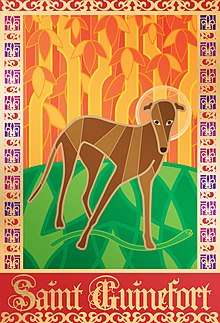Saint Guinefort
| Saint Guinefort | |
|---|---|
 Modern illustration of St. Guinefort | |
| Dog Saint | |
| Died |
13th-century near Lyon, France |
| Venerated in | Folk Catholicism |
| Feast | Venerated locally on August 22 |
| Patronage | Infants |
Catholic cult suppressed | Never recognized officially by Catholic Church; cult persisted until the 1930s by Catholic Church |
Saint Guinefort was a 13th-century French dog that received local veneration as a folk saint after miracles were reported at his grave.[1][2]
Legend
His story is a variation on the well-travelled "faithful hound" motif, similar to the Welsh story of the dog Gelert. Guinefort the greyhound belonged to a knight who lived in a castle near Lyon. One day, the knight went hunting, leaving his infant son in the care of Guinefort. When he returned, he found the nursery in chaos – the cot was overturned, the child was nowhere to be seen and Guinefort greeted his master with bloody jaws. Believing Guinefort to have devoured his son, the knight slew the dog. He then heard a child crying; he turned over the cot and found his son lying there, safe and sound, along with the body of a viper. Guinefort had killed the snake and saved the child. On realizing the mistake the family dropped the dog down a well, covered it with stones and planted trees around it, setting up a shrine for Guinefort. Guinefort became recognised by locals as a saint for the protection of infants. It was alleged by contemporary commentators that locals left their babies at the site to be healed by the dog:
- The local peasants hearing of the dog's noble deed and innocent death, began to visit the place and honor the dog as a martyr in quest of help for their sicknesses and other needs. They were seduced and often cheated by the Devil so that he might in this way lead men into error. Women especially, with sick or poorly children, carried them to the place, and went off a league to another nearby castle where an old woman could teach them a ritual for making offerings and invocations to the demons and lead them to the right spot. When they got there, they offered salt and certain other things, hung the child's little clothes on the bramble bushes around, fixing them on the thorns. They then put the naked baby through the opening between the trunks of two trees, the mother standing on one side and throwing her child nine times to the old woman on the other side, while invoking the demons to adjure the fauns in the wood of "Rimite" to take the sick and failing child which they said belonged to them (the fauns) and return to them their own child big, plump, live and healthy. Once this was done, the killer mothers took the baby and placed it naked at the foot of the tree on the straws of a cradle, lit at both ends two candles a thumbsbreadth thick with fire they had brought with them and fastened them on the trunk above. Then, while the candles were consumed, they went far enough away that they could neither hear nor see the child. In this way the burning candles burned up and killed a number of babies, as we have heard from others in the same place.
- Stephen de Bourbon (d. 1262): De Supersticione: On St. Guinefort.[1][2]
The cult of this dog saint persisted for several centuries, until the 1930s, despite the repeated prohibitions of the Catholic Church.[2]
In popular culture
The 1987 French film Le Moine et la sorcière (in the US known as The Sorceress) depicts the controversy over St. Guinefort as seen through the eyes of Fr. Etienne de Bourbon, a Dominican inquisitor and the author of the above passage.
Thomas of Hookton, the main character in Bernard Cornwell's The Grail Quest trilogy (2000–2003), was a mock believer in Saint Guinefort, praying to the saint and wearing a paw on a piece of leather around his neck.
"Gwenforte" is a prominent canine character in The Inquisitor's Tale by Adam Gidwitz, based on the legends of St. Guinefort.
See also
- Cynocephaly
- Saint Christopher - a saint often portrayed with the head of a dog
- The Brahmin and the Mongoose
- Gelert
Notes
- 1 2 Halsall, Paul (September 8, 2000). "Stephen de Bourbon (d. 1262): De Supersticione: On St. Guinefort Etienne de Bourbon". Medieval Sourcebook. Fordham University. Retrieved October 5, 2013.
- 1 2 3 Dickey, Colin (June 18, 2013). "A Faithful Hound". Lapham's Quarterly. Retrieved September 4, 2016.
External links
- Holy Dogs and Dog-Headed Saints
- The Greyhound Saint
- Halsall, Paul (September 8, 2000). "Stephen de Bourbon (d. 1262): De Supersticione: On St. GuinefortEtienne de Bourbon". Medieval Sourcebook. Fordham University. Retrieved October 5, 2013. (the source text for the story)
- Tuder de Courtecadeno, Mevanwy verch, a/k/a Mark S. Harris (May 2005). "Guinefort: The Sainted Dog of France". The Barge. Stefan's Florilegium. Retrieved October 5, 2013.